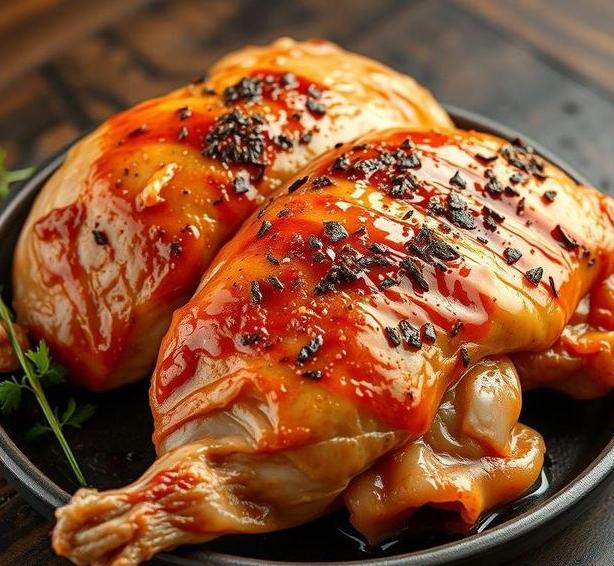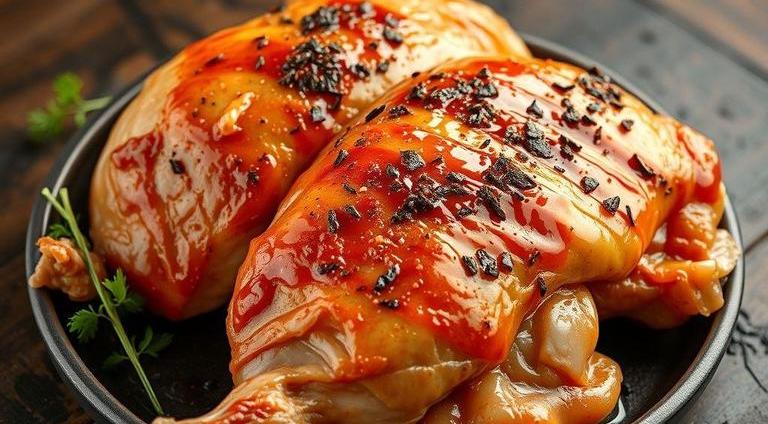Can Chicken Meat Go Bad : What You MUST Know
Chicken is one of the most popular proteins worldwide, known for its versatility, flavor, and affordability. However, with such a staple food item, it’s crucial to know how to handle it properly to ensure it’s safe for consumption. Chicken meat, like other proteins, is highly perishable and can spoil quickly if not stored, cooked, or handled properly. Spoiled chicken not only leads to unpleasant taste and texture but can also pose serious health risks, such as food poisoning caused by bacteria like Salmonella and Campylobacter.
Understanding the shelf life of chicken, the signs of spoilage, and how to store it correctly can go a long way in ensuring that you and your family stay safe while enjoying this protein-packed food.
Can Chicken Meat Go Bad?
Yes, chicken meat can absolutely go bad. In fact, due to its high moisture content and susceptibility to bacteria, chicken is particularly vulnerable to spoilage. Raw or cooked, chicken should be treated with care at every step – from purchasing it at the store to preparing it in your kitchen.
- Raw Chicken: When raw, chicken is a perfect breeding ground for bacteria because of its high moisture levels and temperature sensitivity. Bacteria multiply quickly when it’s left out at room temperature, so it’s crucial to keep it cool from the time you buy it until it’s cooked or frozen.
- Cooked Chicken: Even when cooked, chicken meat is still perishable. Although cooking kills most bacteria, the chicken can still spoil if it’s not stored correctly afterward. Once cooked, the chicken continues to be a potential source of contamination if it’s kept in unsafe conditions.
-
How Does Chicken Go Bad?
- Bacterial Growth: This is the primary cause of spoilage. When chicken is left in the “danger zone” (between 40°F and 140°F), bacteria multiply rapidly, turning the meat unsafe to eat.
- Oxidation: The meat’s fat can oxidize over time, leading to rancid smells and flavors, even in the absence of bacteria.
- Moisture Loss: If chicken is left uncovered or exposed to air, it can dry out and lose its juiciness, which affects both texture and flavor.
Shelf Life For Chicken Meat

The shelf life of chicken meat depends largely on how it is stored and whether it is raw or cooked. Here’s a breakdown of what you can expect:
Raw Chicken Meat
-
Refrigerated (0°F To 40°F)
- Whole Chicken: 1 to 2 days
- Chicken Parts (Breasts, Thighs, Wings, etc.): 1 to 2 days
- Ground Chicken: 1 to 2 days
-
Frozen (0°F Or Below)
- Whole Chicken: Up to 1 year
- Chicken Parts: 9 months
- Ground Chicken: 3 to 4 months
Cooked Chicken Meat
-
Refrigerated (0°F To 40°F)
- Cooked Chicken (All Cuts): 3 to 4 days
-
Frozen (0°F Or Below)
- Cooked Chicken (All Cuts): 4 months
Canned Or Vacuum-Sealed Chicken
- Unopened: Can last for several months or even up to a year, depending on the packaging and storage conditions.
- Opened: Consume within 3 to 4 days after opening if kept in the fridge.
Note: Always check the "use by" or "sell by" date on the packaging, especially for pre-packaged chicken, as it gives a good indication of when the meat is likely to spoil. But it’s not the definitive answer; proper storage is key.
Common Signs Of Spoilage
Knowing the signs that chicken has gone bad is crucial to avoid foodborne illnesses. Here are the most common indicators to look for:
Smell
- One of the most immediate signs that chicken has gone bad is a sour, foul, or ammonia-like smell. Fresh chicken should have little to no odor. If the chicken has a distinct, unpleasant scent, it’s time to discard it.
Color
- Fresh chicken should be pinkish and moist, with a slight sheen. If the chicken starts turning gray, brown, or even greenish, it’s a sign of spoilage.
- For ground chicken, it should be pinkish-red. If it has turned a dull gray or brownish color, discard it.
Texture
- Fresh chicken should be firm, moist, and slightly sticky. If the meat feels slimy or sticky to the touch, it’s a clear sign that bacteria are growing on the surface, making it unsafe to eat.
Excessive Liquid
- If raw chicken is leaking an unusual amount of liquid or has puddles of fluid in its packaging, it could indicate that the meat is decomposing.
Off Taste
- If you’ve already cooked the chicken and it tastes off, sour, or ’off’ in any way, don’t take chances. Trust your taste buds and avoid consuming any questionable meat.
Expiration Dates
- Always check the expiration or sell-by date on the packaging, but remember that these are just guidelines. If the chicken shows any of the signs mentioned above, it’s safer to throw it away even if the date hasn’t passed.
How To Store Chicken Meat?

Proper storage is the key to prolonging the shelf life of chicken and keeping it safe for consumption. Whether it’s raw or cooked, here’s how to store chicken correctly:
Storing Raw Chicken
-
In The Refrigerator
- Store raw chicken in its original packaging or tightly wrap it in plastic wrap, aluminum foil, or a resealable bag.
- Place it on the lowest shelf in the fridge to avoid cross-contamination. This also ensures that any drips do not contaminate other foods.
- Ensure your fridge is set to 40°F or below. Use a thermometer to double-check the temperature regularly.
-
In The Freezer
- Wrap raw chicken tightly in freezer-safe plastic wrap, aluminum foil, or use a vacuum-sealed bag to prevent freezer burn.
- Label the package with the date, so you remember when you froze it.
- Store it in the coldest part of the freezer (usually towards the back or bottom).
Storing Cooked Chicken
-
In The Refrigerator
- Allow cooked chicken to cool down to room temperature (within 2 hours) before refrigerating. Never leave cooked chicken at room temperature for extended periods.
- Store it in an airtight container or tightly wrapped in plastic wrap or foil.
- Place it on a shelf separate from raw foods to prevent cross-contamination.
-
In The Freezer
- Similarly to raw chicken, cooked chicken should be tightly wrapped in freezer-safe materials and labeled with the date.
- Freeze cooked chicken in portions, so you can thaw only what you need.
Expert Tips
- Defrost Safely: Always thaw chicken in the fridge, not at room temperature. If you’re in a hurry, you can defrost it in the microwave, but ensure it’s cooked immediately afterward.
- Use Ice Packs When Transporting: If you’re buying chicken and won’t be home right away, especially in warm weather, use ice packs in your cooler bag to keep the meat at a safe temperature.
- Refrigeration Limits: Even if it’s stored properly, don’t keep raw chicken in the fridge for more than 2 days. If you’re not planning to cook it soon, freeze it to avoid spoilage.
- Avoid Cross-Contamination: Always wash your hands and sanitize surfaces after handling raw chicken. This helps reduce the risk of spreading bacteria.
- Leftovers: When reheating cooked chicken leftovers, ensure it reaches an internal temperature of 165°F to kill any bacteria that might have grown since it was originally cooked.
FAQs
How Long Can Raw Chicken Meat Stay In The Refrigerator Before It Goes Bad?
Raw chicken meat can typically stay in the refrigerator for 1 to 2 days. After this period, the risk of bacterial growth increases, and it should be discarded if not cooked.
What Are The Signs That Chicken Meat Has Gone Bad?
Signs that chicken meat has gone bad include a sour or off smell, a slimy texture, discoloration (such as turning grey), and the presence of mold.
Can Cooked Chicken Meat Go Bad, And How Long Does It Last In The Fridge?
Cooked chicken can last in the refrigerator for 3 to 4 days. After that, it should be discarded to avoid potential foodborne illnesses.
How Can I Store Chicken Meat To Prevent It From Going Bad?
Chicken meat should be stored in an airtight container or tightly wrapped in plastic wrap or aluminum foil. It should be kept in the coldest part of the refrigerator, ideally at or below 40°F (4°C).
Can Chicken Meat Go Bad If It’s Been Frozen?
Freezing chicken meat prevents it from going bad for a longer period. Raw chicken can be stored in the freezer for up to 9 months, and cooked chicken for up to 4 months, if properly sealed.
Is It Safe To Eat Chicken Meat Past Its Expiration Date?
It is not recommended to eat chicken meat past its expiration date, as it may have deteriorated in quality or developed harmful bacteria, even if it looks and smells fine.
What Should I Do If I Suspect My Chicken Meat Has Gone Bad?
If you suspect your chicken meat has gone bad, it’s best to discard it immediately. Do not try to cook or consume it, as it could cause foodborne illnesses like salmonella or E. coli.
How Can I Tell If Ground Chicken Meat Has Gone Bad?
Ground chicken meat may go bad faster than whole chicken. Signs include a sour smell, grayish color, and sliminess. It should be discarded if any of these symptoms appear.
Can Chicken Meat Go Bad If It’s Left Out At Room Temperature?
Yes, chicken meat can go bad if left out at room temperature for more than 2 hours, as bacteria multiply rapidly in temperatures between 40°F (4°C) and 140°F (60°C).
What Temperature Should Chicken Meat Be Cooked To Prevent It From Going Bad?
Chicken should be cooked to an internal temperature of 165°F (74°C) to ensure that any harmful bacteria are destroyed, making it safe to eat.
